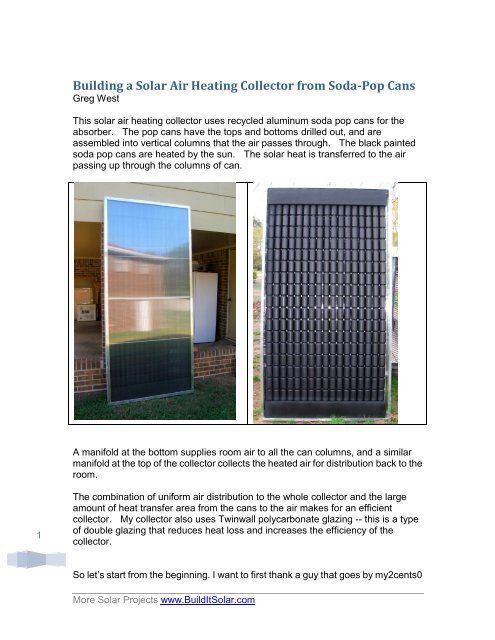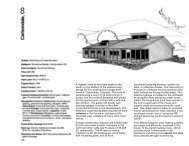Building a Solar Air Heating Collector from Soda-Pop Cans
Building a Solar Air Heating Collector from Soda-Pop Cans
Building a Solar Air Heating Collector from Soda-Pop Cans
You also want an ePaper? Increase the reach of your titles
YUMPU automatically turns print PDFs into web optimized ePapers that Google loves.
1<br />
<strong>Building</strong> a <strong>Solar</strong> <strong>Air</strong> <strong>Heating</strong> <strong>Collector</strong> <strong>from</strong> <strong>Soda</strong>-<strong>Pop</strong> <strong>Cans</strong><br />
Greg West<br />
This solar air heating collector uses recycled aluminum soda pop cans for the<br />
absorber. The pop cans have the tops and bottoms drilled out, and are<br />
assembled into vertical columns that the air passes through. The black painted<br />
soda pop cans are heated by the sun. The solar heat is transferred to the air<br />
passing up through the columns of can.<br />
A manifold at the bottom supplies room air to all the can columns, and a similar<br />
manifold at the top of the collector collects the heated air for distribution back to the<br />
room.<br />
The combination of uniform air distribution to the whole collector and the large<br />
amount of heat transfer area <strong>from</strong> the cans to the air makes for an efficient<br />
collector. My collector also uses Twinwall polycarbonate glazing -- this is a type<br />
of double glazing that reduces heat loss and increases the efficiency of the<br />
collector.<br />
So let’s start <strong>from</strong> the beginning. I want to first thank a guy that goes by my2cents0<br />
More <strong>Solar</strong> Projects www.BuildIt<strong>Solar</strong>.com
2<br />
on YouTube for directing me to the Hungarian website that led me to an engineer<br />
whom I only know as Zoli. He actually speaks better French than Hungarian �. I<br />
want thank Zoli for his upmost patience with me on this project, I bugged him to<br />
death back and forth for nearly three months to make sure I was doing everything<br />
right.<br />
Overview<br />
These are my cans siliconized together with the top manifold on and the bottom<br />
manifold you see on the table. My panel core, is 17 cans wide and 17 cans tall --<br />
this was all I could fit into a four by eight foot insulated box made <strong>from</strong><br />
Polyisocyanurate insulation board (polyiso). The outside of the collector<br />
measures 4 ft by 8 ft. The header caps are 44 ½” with ½” bends on all ends.<br />
I drilled the manifold holes at 54mm dia. and spaced at 66mm on center and came<br />
to find out the can columns would “just fit”. Maybe 67mm O/C might work better<br />
just so things won’t be too tight. Using 67 mm spacing will make the space<br />
between holes 11 to 12 mm which, I think, will work fine. On the next collector I<br />
will use the 67 mm spacing between hole centers. Start 10mm <strong>from</strong> the header<br />
cap end before you start laying out and drilling. I drilled the bottom holes in the<br />
cans out at 44mm and the top ones at 51mm. You need to be very careful with<br />
the tops, because the hole saw will just fit, no room to mess up �.<br />
When cutting the cans with the hole saws I used in a drill press which was a<br />
learning experience in itself. It took a little while and several near miss flying<br />
More <strong>Solar</strong> Projects www.BuildIt<strong>Solar</strong>.com
3<br />
objects to get the hang of it. You would be amazed how fast a hole saw can take<br />
something right out of your hand. So, safety first. Wear safety glasses and<br />
leather gloves that some cotton jersey gloves will fit into. The cans will heat up<br />
rapidly while cutting the tops and bottoms out.<br />
<strong>Building</strong> the Can Columns<br />
At first, I made some wooden jigs to hold the cans while cutting on the drill press.<br />
I used a small rotary saw to start a hole for the diameter of the end of can I was<br />
working on. Then, believe it or not, I took a small straight cut router bit in my drill<br />
press and cut out the rest of the hole.<br />
More <strong>Solar</strong> Projects www.BuildIt<strong>Solar</strong>.com
4<br />
If you have a steady hand, set the depth on your drill press this is pretty easy to do.<br />
Notice my extra hand, a screen door spring holding the router bit to it’s depth. Oh<br />
my, necessity really is the mother of invention. I made the jigs out of large stock of<br />
two 1” x 4” blocks of wood glued together, then cut them down to a size that was<br />
easy to handle.<br />
This jig is for the can tops. I marked the inside shoulder to be more plain and cut<br />
to a depth just enough for the cans neck to fit into. I made a similar holder for the<br />
can bottoms.<br />
More <strong>Solar</strong> Projects www.BuildIt<strong>Solar</strong>.com
5<br />
After all this trouble, I actually found out it was easier to drill the can tops and<br />
bottoms out by just putting the can in a cozy holder as shown in the picture, and<br />
doing the drilling free hand. This is where the leather cloves and cotton jersey<br />
ones come in. As I said before, the 51mm hole saw will just fit the can inside the<br />
can rim. You have to be very careful here -- most times this is where you going to<br />
mess up �. I ran my drill press at it’s medium speed and used Lenox hole saws<br />
-- they cut pretty well. Let the can spin a little if it wants to. Hold the can near the<br />
top with one finger on the can top close to the saw, and the rest of your fingers<br />
resting around the cozy. The can will get hot fast.<br />
Cut out the bottoms of the cans using the 44mm hole saw. This is a breeze after<br />
the first few cans. Just remember to let the can spin a little as you cut it if it wants<br />
to. If you try and hold the can to tight the hole saw will twist the can inside the cozy<br />
-- if this happens, the can will be scrap because it will cause the can to wrinkle and<br />
although you may not see the very minute crack in the can it will be there, I sprayed<br />
primer on one can here as an example.<br />
More <strong>Solar</strong> Projects www.BuildIt<strong>Solar</strong>.com
6<br />
The ring you see around the can will become a leak down the road if you use it<br />
because of the expansion and contraction <strong>from</strong> heat over time. <strong>Soda</strong> cans are<br />
only 10 microns thick, so it won't take long to develop a leak.<br />
Notice the bricks at the lower right of the photo, these are what I used to keep<br />
pressure on the cans after the silicone was applied. Some cans with the tops and<br />
bottoms cut out.<br />
More <strong>Solar</strong> Projects www.BuildIt<strong>Solar</strong>.com
7<br />
I used a 3” PVC pipe cut in half to hold my can tubes while the silicone cured. One<br />
note, buy an end cap for the pipe, it will make things a little easier. I’ll do that next<br />
time. Cut the end cap in half and glue it to your pipe. 1”x 4” boards nailed<br />
together will work just as good I think but I have not tried that yet.<br />
Here’s the photos of the can tube construction, I just put silicone around the small<br />
end of the can, pressed them together while in the PVC tube and while using one<br />
finger to smooth the silicone joint I used my other hand to turn the tube as I went<br />
along.<br />
More <strong>Solar</strong> Projects www.BuildIt<strong>Solar</strong>.com
8<br />
You can see at the left one tube already complete in its PVC holder.<br />
Let your hand rest gently on the left can while turning the assembly with your other<br />
hand, thumb and fore finger.<br />
More <strong>Solar</strong> Projects www.BuildIt<strong>Solar</strong>.com
9<br />
There’s that brick again, I was doing this in my living room floor because it was to<br />
cold to do it out in my shop. If incline the tube a little the brick will have enough<br />
pressure to keep everything in place until the silicone sets. I did this until I had a<br />
stack 17 cans tall and 17 wide to fit the 44.5” wide manifold plates I had drilled out<br />
for them. Ok, you have your tube stacks made. If your collector is not 4 ft by 8 ft,<br />
you will have to work out the number and length of can columns for the size you are<br />
building.<br />
More <strong>Solar</strong> Projects www.BuildIt<strong>Solar</strong>.com
10<br />
<strong>Building</strong> the Manifolds<br />
Figure 1 Manifold distributes air evenly to the can columns (drawing <strong>from</strong> Zoli)<br />
First I took a 1” x 4” and measured out the dimensions given to me by Zoli <strong>from</strong> his<br />
SketchUp drawing and drilled a test manifold to make sure everything would fit. It<br />
was tight. Since everything over in the UK etc. is metric that is what I used. The<br />
closest hole saw I could come up with for the cans was a 54mm. The plans called<br />
for 55mm holes spaced 66mm on center. I started 10mm <strong>from</strong> the edge of the<br />
manifold and did my layout. I think that spacing the holes 67mm on center would<br />
not hurt on the manifold layout, as there sufficient room to do this.<br />
I just clamped a scrap of 1 x 4 under the manifold plate while drilling free hand. This<br />
worked out well for me. Here’s a photo of drilling the cans free hand. Be very<br />
careful.<br />
More <strong>Solar</strong> Projects www.BuildIt<strong>Solar</strong>.com
11<br />
After I had done all this I fitted the can tubes into the top and bottom manifold<br />
plates and used silicone to seal them in place.<br />
Don’t be afraid to use plenty of silicone here, but don’t block the air way. After this<br />
measure what you have. Then cut aluminum flat plates to that make up the front,<br />
back and bottom of the manifold. Size them so that the whole can and manifold<br />
assembly fits snugly into the 4’ x 8’ Polyiso housing. The manifold box ends up<br />
More <strong>Solar</strong> Projects www.BuildIt<strong>Solar</strong>.com
12<br />
being approx 6.75" tall by 3.5” deep 44.5” wide.<br />
The photo above is of the new style manifold with air disrupters installed and end<br />
caps which I had to make myself.<br />
I made<br />
these out of aluminum house trim coil and had to cut the radius on the ends to<br />
make them fit on each end of the manifolds.<br />
More <strong>Solar</strong> Projects www.BuildIt<strong>Solar</strong>.com
13<br />
Making the end caps<br />
I did this on top of my saw table just using some clamps and straight edge. Just<br />
bend the sheet up with your hands then tap along the edge with a hammer and you<br />
will come out with a nice edge.<br />
Painting and Final Assembly<br />
Here’s a photo of the painted pane core. Do the painting outside of your shop or<br />
house.<br />
You want the core housing to be reflective so that any sun that passes by the core<br />
will be bounced back onto the core.<br />
Photo of the intake with cover I made <strong>from</strong> aluminum and mounted a 6” duct fitting<br />
to it, I did the same for the outlet.<br />
More <strong>Solar</strong> Projects www.BuildIt<strong>Solar</strong>.com
14<br />
More <strong>Solar</strong> Projects www.BuildIt<strong>Solar</strong>.com
15<br />
Photo of outlet as you can see I only had a picture to go by, just simple air<br />
deflectors. Zoli said it looked good to him �<br />
Photo of the core, 3” pipe and cans<br />
Some photos of housing.<br />
More <strong>Solar</strong> Projects www.BuildIt<strong>Solar</strong>.com
16<br />
I protected all exposed polyiso board with Aluminum tape, the inside corners also.<br />
More <strong>Solar</strong> Projects www.BuildIt<strong>Solar</strong>.com
17<br />
I then used silicone on all inside edges of the tape just to make sure they didn’t<br />
work loose over time as I’ve found out can happen.<br />
The outside surfaces of the Polyiso are protected <strong>from</strong> the weather by aluminum<br />
trim pieces.<br />
More <strong>Solar</strong> Projects www.BuildIt<strong>Solar</strong>.com
18<br />
Photo of collector in it’s housing. You can see the reflection <strong>from</strong> the back of the<br />
housing here.<br />
More <strong>Solar</strong> Projects www.BuildIt<strong>Solar</strong>.com
19<br />
And this photo of collector on it’s side in my shop.<br />
And the finished collector below. The strip you see in the center is to keep the<br />
panel <strong>from</strong> expanding over four feet wide which it would do when heated up. I also<br />
have 3/8ths inch aluminum rods in place to help support the twin walled<br />
polycarbonate panel and to keep it <strong>from</strong> bowing as it heats up.<br />
This collector can also be mounted vertical or horizontal on the south side of your<br />
home and it will work fine.<br />
The only test I have run so far with Gary’s help was with the collector laying on it’s<br />
back on saw horses with the glazing just held on with some quick clamps. The test<br />
was promising with the collector running at 91cfm at a 60 F degree temperature<br />
rise. I would like to see it run at 100cfm at around a 50 to 55 F degree temp rise but<br />
that means a more powerful and louder fan which would require a muffler of some<br />
sort.<br />
One more note on the polycarbonate panel. The people at Tex Supply told me to<br />
be sure and cut the panel one half inch shorter than the collector frame all the way<br />
around because it would expand when heating up and they were right, it did -- a lot.<br />
To seal the glazing to the panel I used polyurethane foam in case anything were to<br />
go wrong down the road I can get into the panel easy.<br />
More <strong>Solar</strong> Projects www.BuildIt<strong>Solar</strong>.com
20<br />
Not a bad looking panel for my first one, can’t wait to build another �<br />
More <strong>Solar</strong> Projects www.BuildIt<strong>Solar</strong>.com
21<br />
More <strong>Solar</strong> Projects www.BuildIt<strong>Solar</strong>.com
22<br />
Greg<br />
September 5, 2010<br />
You can email Greg questions at: gwest77 AT comcast DOT net (type @ for AT<br />
and a period for DOT)<br />
Can <strong>Collector</strong> Resources:<br />
Zoli's website... (in Hungarian -- use Google Translate for English)<br />
Gary's collection of pop-can collector links...<br />
More <strong>Solar</strong> Projects www.BuildIt<strong>Solar</strong>.com






